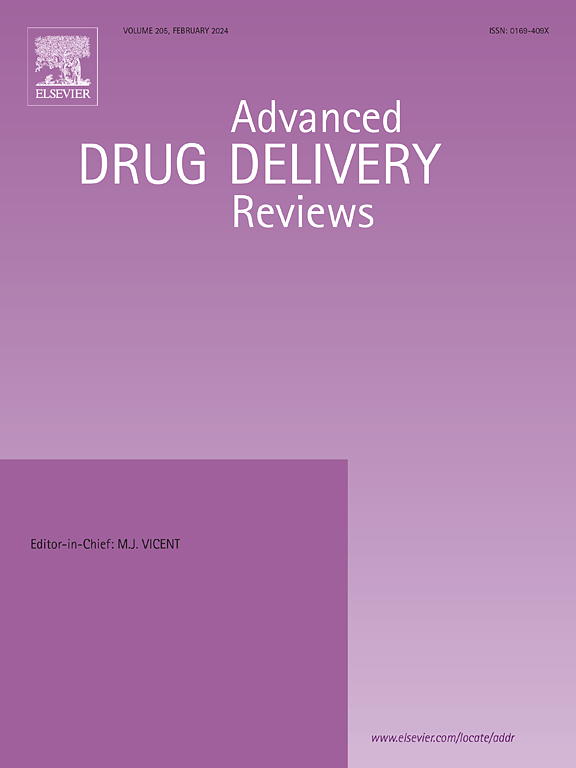靶向脑神经变性的纳米药物:关键障碍和昼夜节律考虑
IF 17.6
1区 医学
Q1 PHARMACOLOGY & PHARMACY
引用次数: 0
摘要
开发治疗中枢神经系统疾病(CNS)的新疗法,特别是像阿尔茨海默病(AD)这样的神经退行性疾病,是全球卫生领域的一个重要重点。生物疗法,如单克隆抗体(mab)和基于rna的疗法,已经显示出治疗脑部疾病的潜力。然而,由于难以接近大脑靶点,它们的临床进展受到限制。在临床前水平,纳米技术已经被证明可以帮助这些分子克服阻碍其充分向大脑传递的生物障碍。这篇综述强调了这一领域的进展以及转化为临床的挑战。重点分析了基于纳米技术的关键策略,如利用内源性蛋白冠进行表面修饰,靶向配体功能化,超声介导的治疗性微泡振荡。此外,与特刊的重点一致,这篇综述整合了时间疗法的概念,重点是阿尔茨海默病的治疗,强调了通过将纳米颗粒(NP)为基础的药物递送与昼夜节律结合起来,有可能改善治疗结果。最后,本文分析了目前临床试验中中枢神经系统给药的策略,并在此框架内提供了未来的方向,特别是在AD领域。本文章由计算机程序翻译,如有差异,请以英文原文为准。


Nanomedicine for targeting brain Neurodegeneration: Critical barriers and circadian rhythm Considerations
The development of novel therapies for central nervous system (CNS) diseases, particularly neurodegenerative disorders like Alzheimer’s disease (AD), is a critical global health priority. Biotherapeutics, such as monoclonal antibodies (mAbs) and RNA-based therapies, have shown potential for treating brain disorders. However, their clinical progress is limited by their difficult access to their brain targets. At the preclinical level, nanotechnology has been shown, to help these molecules overcome the biological barriers that imped their adequate brain delivery. This review highlights advances in this area and the challenges for the translation to the clinic. Key nanotechnology-based strategies, such as surface modifications utilizing endogenous protein corona, functionalization with targeting ligands, therapeutic ultrasound-mediated microbubble oscillation were particularly analyzed. Additionally, in line with the focus of the Special Issue, this review integrates the concept of chronotherapy, with a focus on AD treatment, highlighting the idea that, by aligning nanoparticle (NP)-based drug delivery with circadian rhythms, it may be possible to improve therapeutic outcomes. Finally, the article analyzes current strategies in CNS drug delivery in clinical trials and provides future directions within this frame, notably in the area of AD.
求助全文
通过发布文献求助,成功后即可免费获取论文全文。
去求助
来源期刊
CiteScore
28.10
自引率
5.00%
发文量
294
审稿时长
15.1 weeks
期刊介绍:
The aim of the Journal is to provide a forum for the critical analysis of advanced drug and gene delivery systems and their applications in human and veterinary medicine. The Journal has a broad scope, covering the key issues for effective drug and gene delivery, from administration to site-specific delivery.
In general, the Journal publishes review articles in a Theme Issue format. Each Theme Issue provides a comprehensive and critical examination of current and emerging research on the design and development of advanced drug and gene delivery systems and their application to experimental and clinical therapeutics. The goal is to illustrate the pivotal role of a multidisciplinary approach to modern drug delivery, encompassing the application of sound biological and physicochemical principles to the engineering of drug delivery systems to meet the therapeutic need at hand. Importantly the Editorial Team of ADDR asks that the authors effectively window the extensive volume of literature, pick the important contributions and explain their importance, produce a forward looking identification of the challenges facing the field and produce a Conclusions section with expert recommendations to address the issues.

 求助内容:
求助内容: 应助结果提醒方式:
应助结果提醒方式:


